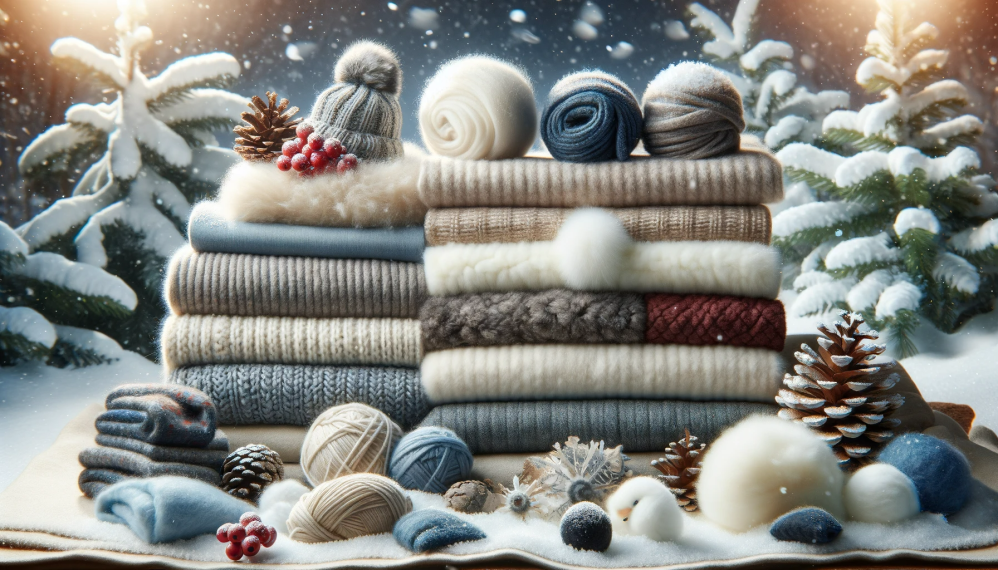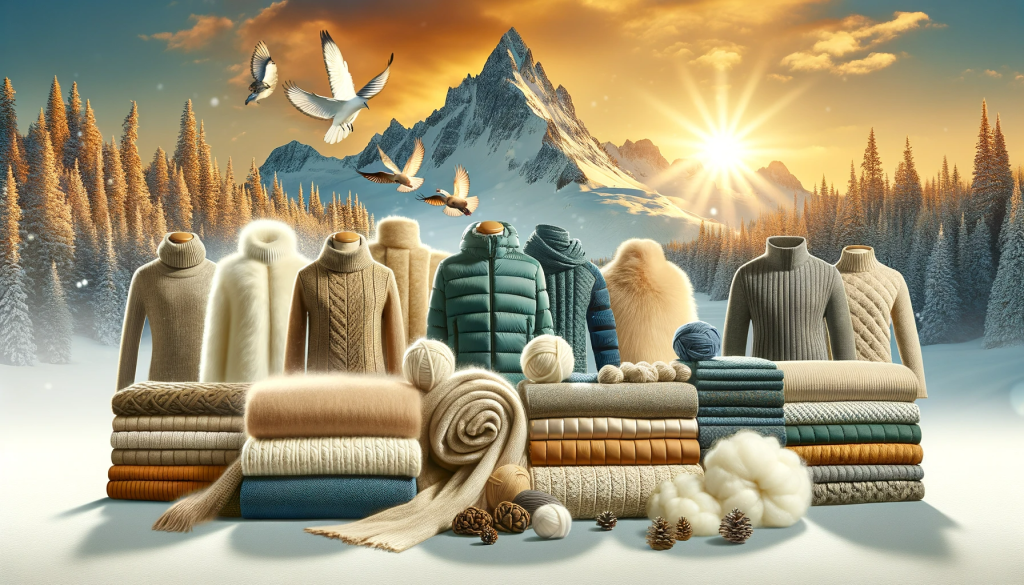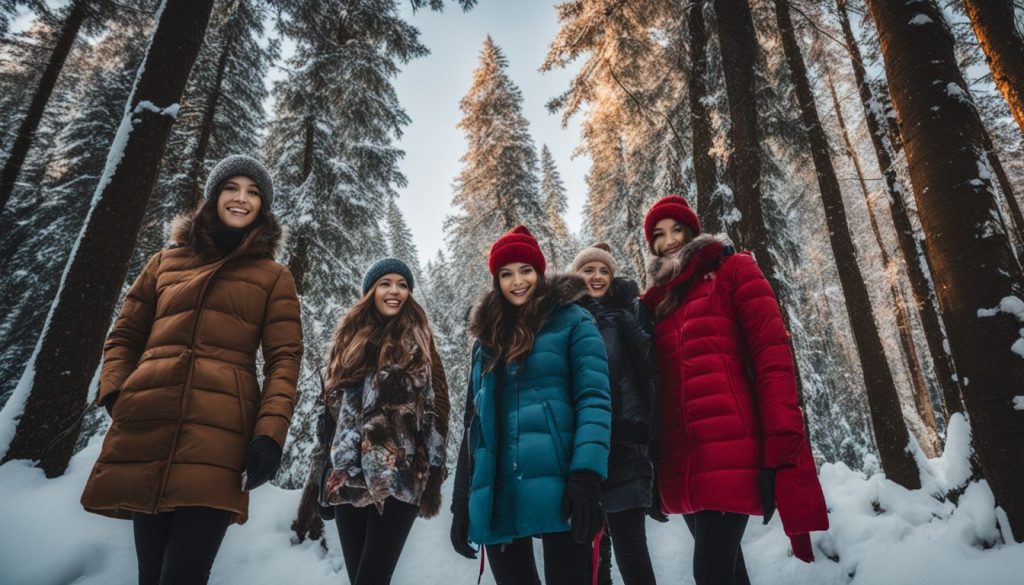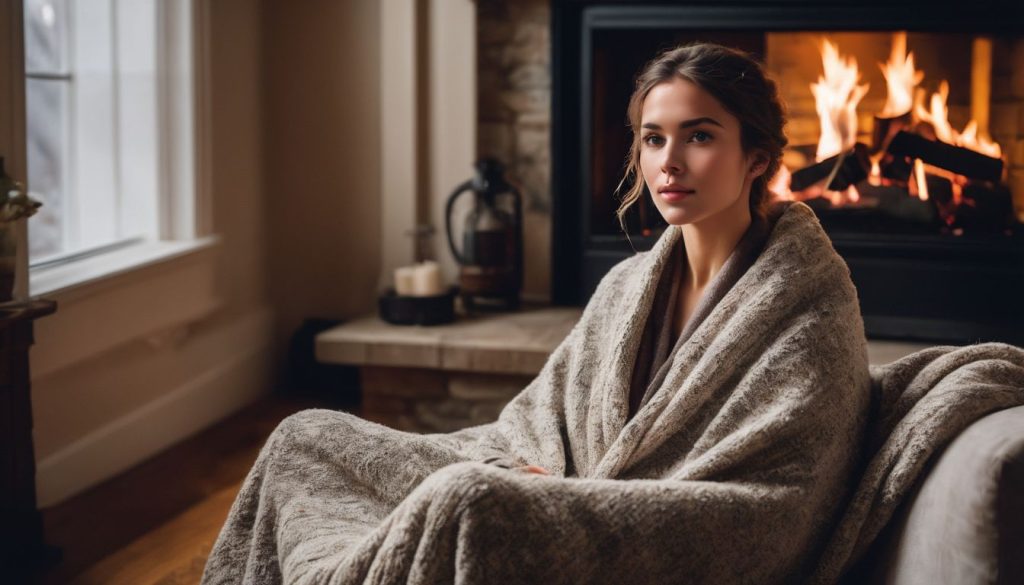
As winter’s chill sets in, finding the right fabric to keep you warm becomes a top priority. Did you know that cotton can be woven thick enough for chilly days, yet light enough for summer wear? Our guide dives into the ten best fabrics for the cold weather, ensuring comfort and warmth.
Discover your coziest winter yet.
Key Takeaways
- Wool, particularly Merino and Icelandic wool, provides excellent insulation with natural fibers that create air pockets to trap heat.
- Cashmere offers a luxurious and extremely warm option for winter, being softer and warmer than other wools.
- Fleece is not only warm and soft but also moisture – resistant and durable, making it ideal for active outdoor use in cold weather.
- Silk functions as an effective thermal base layer due to its lightweight insulating properties while being breathable and hypoallergenic.
- Polyester stands out for its durability, quick – drying qualities, and versatility in style; it’s especially practical in synthetic blends like Sherpa polyester.
Top 10 Best Fabrics for Cold Weather
When the temperature drops, staying warm and cozy becomes a top priority. The fabrics we choose for our winter wardrobe can make all the difference, so let’s explore the power players in the textile world that are renowned for their insulating properties and comfort during cold weather.
Wool
Wool stands out in the cold weather fabric lineup for its impressive ability to retain warmth. Its natural fibers create tiny air pockets that trap heat, acting as a formidable barrier against the chill.
Lightweight yet strong, wool’s durability means that your winter wardrobe will not only keep you cozy but also last through many seasons. Opting for Merino wool takes comfort to the next level, offering a softness that rivals synthetics and ensures you stay warm without feeling itchy.
Icelandic wool raises the bar even higher with superior insulation properties confirmed by science—it’s warmer than both cotton and polyester. Tweed and flannel join this elite group of insulators due to their densely woven structures capable of locking in body heat while repelling cold air.
As our guide progresses beyond the realm of traditional textiles, prepare to discover how cashmere earns its reputation as one of luxury’s favorite fabrics.
Cashmere
Moving beyond the classic warmth of wool, cashmere steps up as a luxurious contender in your winter wardrobe. Known for its ultra-soft texture and impressive insulating properties, cashmere sweaters and scarves offer both comfort and elegance.
This fabric sets itself apart by being significantly warmer than even the finest merino wools, making it a favorite for those seeking extra protection against the chill.
While often associated with high fashion and indulgent style, quality cashmere goes beyond appearance; it’s remarkably durable when cared for properly. A well-loved piece can accompany you through countless winters, retaining its shape and softness wear after wear.
Despite concerns about sustainability linked to production practices, the enduring nature of cashmere items means fewer replacements over time—arguably adding value to every thread.
Silk
Moving from the cozy warmth provided by fleece, let’s turn our attention to silk, a fabric that shines in its role as a thermal base layer for those brisk winter days. Despite its lightweight nature, silk packs a hefty punch when it comes to insulation.
Its fibers hold heat close to the body, offering you an invisible shield of warmth without adding bulk under your garments. This makes silk not just practical but also an elegant choice for anyone aiming to stay warm without compromising on style.
Silk carries additional benefits beyond its insulating properties; it’s hypoallergenic and soft against the skin, preventing irritation even after long hours of wear. Ideal for delicate or sensitive skin types, this breathable material keeps you comfortably dry by allowing sweat to evaporate swiftly.
By incorporating silk into your cold-weather arsenal as an innermost layer, you can enjoy both luxury and functionality as it smoothly supports your winter endeavors with unmatched comfort and subtle charm.
Polyester
Polyester stands out as a top pick in the winter fabric lineup, bringing durability and warmth to cold weather wardrobes without weighing you down. As a synthetic fiber, it excels at retaining heat while offering the added benefit of quick drying after exposure to snow or rain – making it an ideal choice for anyone active during the chilly months.
Its uncomplicated care instructions mean less hassle when dealing with laundry, so you can spend more time enjoying winter activities and less on maintenance.
In addition to its practical features, polyester also steps up style-wise; take Sherpa polyester as an example. Designed to emulate sheep’s wool texture, this variant offers both exceptional warmth and a plush look that enriches any garment from jackets to blankets.
It injects extra insulation into layers while giving your cold-weather gear that cozy appeal often sought during frosty seasons. With polyester’s versatility in form and function, incorporating this fabric into your winter wear ensures comfort without compromising on quality or style.
Fleece
Fleece stands out as a prime contender for cold-weather comfort, thanks to its impressive insulation capabilities. This fabric boasts a unique napped surface that not only feels soft against the skin but also traps heat efficiently to keep you snug even on the chilliest days.
Incorporating fleece into your winter wardrobe means embracing a material designed to retain body heat effectively, ensuring you stay warm whether you’re hitting the slopes or just braving the outdoor elements.
Durability is another key advantage of this cozy textile. Fleece can endure harsh conditions and comes out looking good as new after countless washes, making it an extremely practical option for anyone’s winter collection.
Furthermore, if you find yourself caught in a surprise shower or snowstorm, fleece won’t let you down—it repels moisture and dries quickly, keeping dampness at bay. Opting for fleece garments could be your best strategy for tackling extreme weather without sacrificing comfort or convenience.
Cotton
Cotton stands as a familiar favorite in the textile world, especially for those who seek comfort and durability in their winter gear. Its natural fibers provide reliable insulation, keeping you warm when temperatures drop.
Yet its true strength lies in its versatility; cotton pieces can easily transition between seasons, serving as a staple in both your summer and winter wardrobes.
However, cotton’s ability to absorb moisture poses challenges during colder months. Wetness from snow or sweat might trap chill against your skin because wet cotton loses much of its insulating properties.
To stay snug and dry, consider layering cotton with other thermal materials that wick moisture away or save it for drier days where its breathability will shine without the risk of dampness drawing heat away from your body.
Leather
Leather stands out as a top choice for cold weather gear, boasting impressive insulating properties that lock in warmth. This durable material has been trusted through the ages to fend off chilly winds and maintain cozy comfort.
Leather jackets, shoes, and pants are not just fashion statements; they’re also practical pieces of winter clothing designed to withstand cold environments.
The option of faux leather offers similar thermal benefits, illustrating leather’s versatility in catering to different preferences while still prioritizing insulation. Whether you’re exploring icy city streets or embarking on a frosty adventure outdoors, incorporating leather into your winter apparel ensures robust protection against the elements.
Fur
Fur brings unmatched warmth and natural insulation to your winter wardrobe. Its thick, soft hairs trap heat close to the body, making it one of the most sought-after fabrics for combating freezing temperatures.
Both genuine fur and top-quality faux options provide a cozy shield against the chill, serving as a stylish yet functional choice for cold-weather clothing and accessories.
Choosing fur means opting for enduring comfort during harsh winter months. With its superior thermal properties, fur ensures that you stay warm whether you’re braving an icy storm or simply taking a stroll on a frosty day.
It’s not just about staying warm; fur adds an element of luxury to any cold weather attire, blending timeless elegance with practical heat retention on even the coldest days.
Velvet
Velvet stands out as a luxurious choice for those seeking both elegance and warmth in their winter attire. Its thickness and plush texture provide insulation against the chill, making it a high-ranking fabric on our list of cold weather essentials.
Known for its opulent sheen and sumptuous feel, velvet adds a touch of sophistication to any winter wardrobe.
Crafted through the unique process of cut pile weaving, velvet offers an unparalleled comfort that is as pleasing to the touch as it is to the eye. Whether you opt for classic velvet, velveteen with its shorter pile, or stretchy velour; these variants all ensure that style doesn’t come at the expense of staying cozy.
Moving beyond this regal material, let’s explore Mashru Gaji next—a blend known for combining silk-like luxury with practical warmth.
Mashru Gaji
While velvet offers a luxurious feel, Mashru Gaji is the go-to for exceptional warmth and comfort in bone-chilling temperatures. This unique wool fabric stands out as an insulating powerhouse among cold weather textiles, making it an excellent choice for those seeking to stay warm when the mercury drops.
Its tightly woven fibers trap heat close to your body, acting as a thermal barrier against the cold.
Mashru Gaji has earned its place alongside wool and cashmere as one of the most recommended fabrics for winter apparel. Whether you’re layering up for outdoor adventures or simply aiming to keep cozy indoors, garments made from this material are essential additions to any winter wardrobe.
The inherent properties of Mashru Gaji provide not only insulation but also breathability, ensuring that you remain snug without overheating during colder months.
How to Choose the Best Fabric for Your Winter Clothing

Selecting the ideal fabric for your winter attire goes beyond just picking what looks good; it’s about understanding how different materials can shield you from the chill while keeping you comfortable.
Unveil the secrets of fabrics that cater to warmth and functionality, ensuring your winter wardrobe stands up to the season’s demands.
Consider the Warmth, Breathability, and Moisture-Wicking Capabilities
Choosing the right winter fabric means prioritizing warmth without sacrificing comfort. Fabrics with good insulation trap body heat, providing a thermal barrier against cold air. Wool, for example, is a superb choice because it not only keeps you toasty but also breathes well, reducing the risk of overheating.
Performance fabrics that offer moisture management are essential for staying dry during winter activities. Materials like a merino wool-polyester blend have excellent moisture-wicking properties and resist odors, making them ideal for active wear where temperature regulation is key.
Look for these capabilities to ensure peak performance and comfort in your winter wardrobe choices.
Look for Natural Fabrics or Blends
Natural fabrics like wool and cotton bring unbeatable warmth and breathability to winter clothing. Wool, with its superior insulating properties, stands out as the warmest choice for chilly days.
It keeps you cozy by trapping body heat and wicks away moisture, preventing that clammy feeling under layers. Cotton steps in with softness and comfort especially when woven into flannel or used in denim – perfect for those casual outings or a day at the office.
Fabric blends marry the best of both worlds: natural fibers’ comfort with manmade materials’ durability. These combinations often enhance a garment’s ability to hold shape while still providing insulation.
They can offer additional features too, like easy-care or stretchiness, which pure natural fibers may not have on their own. When selecting your winter wardrobe essentials, consider how these blended materials could add function alongside style and coziness.
Pay Attention to the Fabric Weight
Fabric weight plays a critical role in how well your clothing will protect you from the cold. Heavier fabrics often offer more insulation, trapping heat close to your body and keeping the winter chill at bay.
Imagine wrapping yourself in a thick wool coat; its substantial weight comes from densely packed fibers that are excellent at holding warmth. On the other hand, lighter materials may not provide sufficient protection on their own but can be perfect for layering.
Opting for items like a wool-acrylic blend might give you the best of both worlds: warmth without too much bulk. Clothes with this mix benefit from the insulating properties of wool while being complemented by acrylic’s durability and lower cost.
Always consider the fabric’s heft alongside its other features to ensure it meets your needs for outdoor activities or cozy indoor gatherings during colder months. A smart choice based on fabric weight ensures comfort and maintains necessary body warmth without sacrificing style or freedom of movement.
Consider the Type of Clothing and Activity Level
After assessing the weight of your chosen winter fabrics, take a moment to reflect on what you’ll be wearing them for. Different activities demand distinct types of clothing, and understanding this can guide you in selecting materials that enhance performance and comfort.
For someone who’s always on the go, athletic wear such as spandex is unrivaled due to its ability to keep warmth close without restricting movement – vital when temperatures drop but your activity level doesn’t.
Selecting weather-resistant materials like Gore-Tex is equally essential for those participating in winter sports where exposure to elements is high. This fabric stands up against harsh conditions while allowing moisture from sweat to escape, ensuring that wet clothes don’t become an unwelcome distraction.
For active outdoor enthusiasts, combining synthetic blends with insulating materials allows for maximum thermal insulation while remaining light enough not to impede agility or endurance during vigorous pursuits.
Conclusion – The Best Fabrics for Cold Weather
Embrace the chill with confidence by selecting the right winter fabrics. Keep warmth wrapped around you like a cozy hug with materials designed for cold weather. Remember, your choice in textiles can be both stylish and functional.
Making smart choices means staying comfortable no matter how low the thermometer drops. Let these tips guide you to maintaining that perfect balance of fashion and function all winter long.
FAQs
1. What fabrics are best for keeping warm in the cold weather?
Wool, fleece, and thermal cotton are among the top fabrics for warmth in winter.
2. Can I wear silk in cold weather?
Yes, silk is a good choice as it can provide insulation while being lightweight.
3. Are synthetic fabrics good for winter?
Synthetic fabrics like polyester and nylon are excellent at retaining heat and repelling water during winter.
4. Is denim a suitable fabric for cold climates?
Denim can be suitable for mild cold but may not offer enough insulation for very low temperatures without layering.
5. Do I need to layer different fabrics to stay warm outdoors?
Layering different fabrics such as wool under jackets or coats provides added protection against extreme cold conditions.

